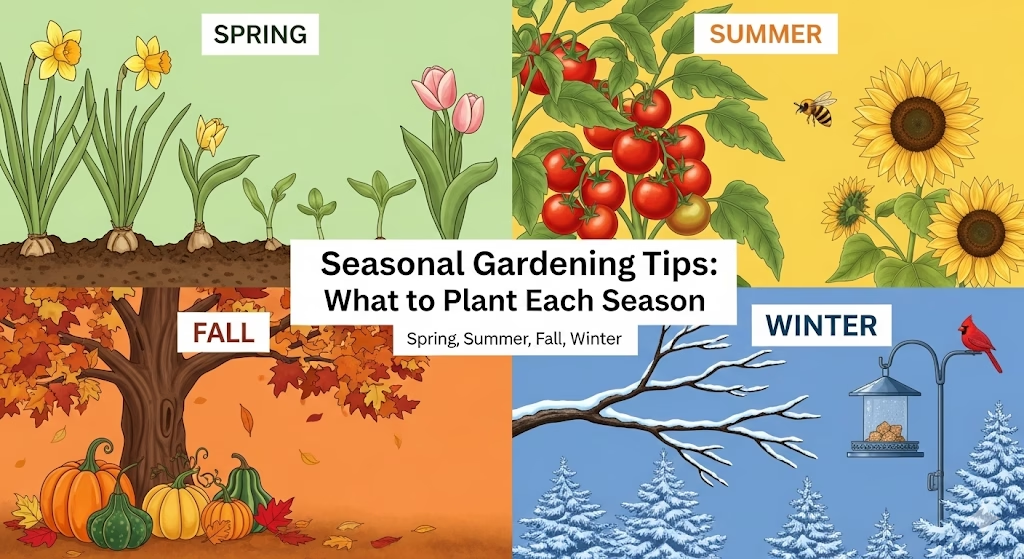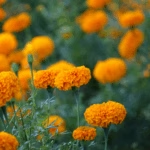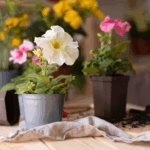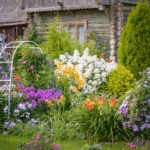Introduction
Gardening isn’t just about planting seeds—it’s about timing. Every season has its rhythm, with certain crops thriving in warm, sunny weather while others prefer cooler days. By understanding seasonal gardening tips, you can maximize your harvest, reduce plant stress, and keep your garden blooming all year.

In this guide, we’ll explore what to plant in spring, summer, fall, and winter, along with expert care tips to ensure your garden thrives season after season.
Why Seasonal Gardening Matters
- Better Yields: Plants grown in the right season produce higher yields.
- Fewer Pests & Diseases: Certain pests thrive only in specific seasons. Planting at the right time minimizes exposure.
- Soil Health: Rotating crops seasonally prevents soil depletion.
- Cost-Effective: Seasonal produce requires fewer resources, reducing fertilizer and water use.
According to The Old Farmer’s Almanac, aligning your planting schedule with seasonal conditions can increase crop success by over 30%.
Spring Gardening Tips
Spring symbolizes new beginnings. Warmer soil, longer daylight hours, and gentle rainfall make it ideal for planting a wide range of crops.
Vegetables to Plant in Spring
- Lettuce
- Spinach
- Broccoli
- Carrots
- Peas
- Radishes
- Kale
These crops germinate quickly in cool soil and provide early harvests.
Flowers to Plant in Spring
- Tulips
- Daffodils
- Pansies
- Snapdragons
- Marigolds
Bright flowers not only beautify gardens but also attract pollinators essential for vegetable crops.
Herbs for Spring
- Parsley
- Dill
- Cilantro
- Chives
Expert Tip
Start seeds indoors for tomatoes, peppers, and eggplants in early spring. By the time the last frost passes, seedlings will be ready to transplant outdoors.
Summer Gardening Tips
Summer offers long, hot days perfect for sun-loving plants. However, heat stress, pests, and watering challenges are common issues gardeners must address.
Vegetables to Plant in Summer
- Tomatoes
- Cucumbers
- Zucchini
- Beans
- Eggplant
- Sweet corn
- Peppers
Flowers to Plant in Summer
- Sunflowers
- Zinnias
- Petunias
- Dahlias
- Cosmos
These flowers thrive in heat and add vibrant color to any garden.
Herbs for Summer
- Basil
- Oregano
- Thyme
- Rosemary
- Lemongrass
Watering & Care Tips
- Water deeply 2–3 times per week instead of shallow daily watering.
- Mulch around plants to retain soil moisture.
- Install drip irrigation for efficient watering.
Did You Know? Tomatoes need 6–8 hours of direct sunlight daily for maximum fruit production.
Fall Gardening Tips
Fall is often overlooked, yet it’s a prime season for planting cool-weather crops. With soil still warm from summer and cooler nights, germination and growth are steady.
Vegetables to Plant in Fall
- Kale
- Brussels sprouts
- Cauliflower
- Beets
- Garlic
- Onions
- Radishes
Flowers to Plant in Fall
- Chrysanthemums
- Asters
- Pansies
- Ornamental cabbage
- Rudbeckia
Herbs for Fall
- Sage
- Mint
- Chervil
- Tarragon
Soil Prep for Winter
- Add organic compost to enrich the soil.
- Plant cover crops like clover or rye to prevent erosion and improve fertility.
According to University of Minnesota Extension, fall planting strengthens root development, giving plants a head start for spring.
Winter Gardening Tips
In colder regions, winter gardening may seem impossible. But with proper planning, you can grow hardy crops outdoors and tender ones indoors.
Vegetables to Plant in Winter
- Spinach
- Swiss chard
- Lettuce (cold-resistant varieties)
- Carrots
- Radishes
- Turnips
Flowers to Plant in Winter
- Camellias
- Winter jasmine
- Hellebores
- Hardy pansies
Herbs for Winter
- Rosemary
- Thyme
- Parsley (with protection)
- Chives (indoors)
Protection Techniques
- Use greenhouses or cold frames.
- Cover crops with row covers or cloches.
- Grow herbs indoors on sunny windowsills.
Seasonal Gardening Chart
| Season | Vegetables | Flowers | Herbs |
|---|---|---|---|
| Spring | Lettuce, peas, carrots | Tulips, marigolds | Parsley, cilantro |
| Summer | Tomatoes, cucumbers, beans | Sunflowers, zinnias | Basil, oregano |
| Fall | Kale, garlic, beets | Chrysanthemums, asters | Sage, mint |
| Winter | Spinach, lettuce, radishes | Camellias, pansies | Rosemary, thyme |
Tips for Year-Round Gardening
- Crop Rotation: Prevents pests and maintains soil nutrients.
- Mulching: Helps regulate soil temperature and conserve water.
- Soil Testing: Adjust pH and nutrients seasonally.
- Pest Monitoring: Seasonal pests vary—aphids in spring, beetles in summer, cabbage worms in fall.
- Plan Ahead: Use a garden journal or calendar to track planting and harvesting times.
Seasonal Gardening for Small Spaces
Not everyone has a large backyard, but seasonal gardening can still thrive in:
- Containers: Grow herbs, lettuce, or cherry tomatoes in pots.
- Raised Beds: Perfect for small yards or urban gardens.
- Vertical Gardens: Use trellises or wall planters for climbing crops.
FAQs About Seasonal Gardening
1. What is the easiest season to start gardening?
Spring is the best season for beginners, thanks to mild temperatures and a wide variety of crops.
2. Can I grow vegetables in winter without a greenhouse?
Yes, with cold frames, row covers, or by choosing hardy crops like kale and spinach.
3. Which vegetables grow year-round?
Carrots, lettuce, spinach, and herbs like parsley can be grown across multiple seasons.
4. What is the best way to prepare soil for seasonal gardening?
Add compost, test soil pH, and rotate crops annually.
5. Can I mix flowers and vegetables in the same bed?
Yes—marigolds, nasturtiums, and sunflowers make excellent companion plants.
Conclusion
Gardening is a year-round activity when you understand seasonal planting. Spring brings leafy greens and early flowers, summer delivers abundance, fall provides cool-weather crops, and winter—with the right tools—still offers fresh harvests.
By following these seasonal gardening tips, you’ll ensure healthier soil, stronger plants, and a continuous supply of vegetables, herbs, and flowers.
Call to Action: Ready to plan your garden? Visit Agzora.com for planting calendars, composting guides, and expert gardening advice.





